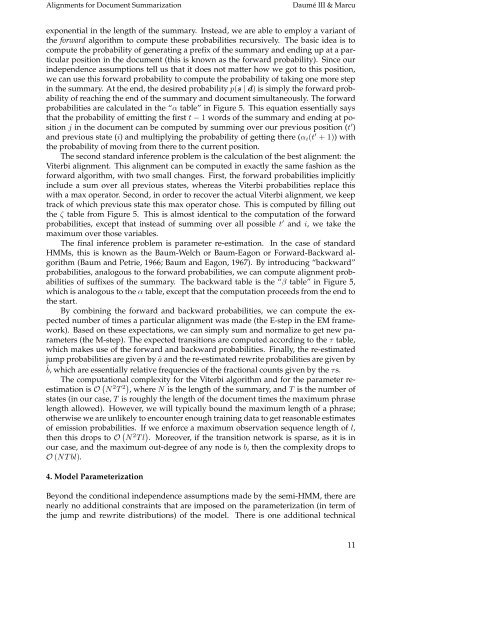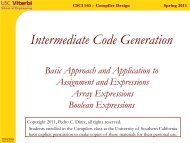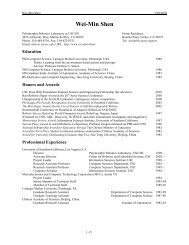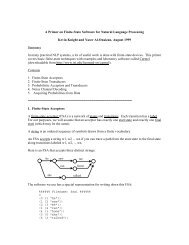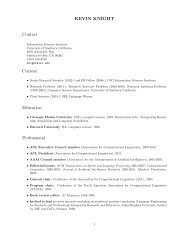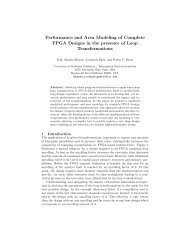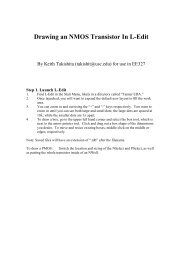Induction of Word and Phrase Alignments for Automatic Document ...
Induction of Word and Phrase Alignments for Automatic Document ...
Induction of Word and Phrase Alignments for Automatic Document ...
Create successful ePaper yourself
Turn your PDF publications into a flip-book with our unique Google optimized e-Paper software.
<strong>Alignments</strong> <strong>for</strong> <strong>Document</strong> Summarization Daumé III & Marcu<br />
exponential in the length <strong>of</strong> the summary. Instead, we are able to employ a variant <strong>of</strong><br />
the <strong>for</strong>ward algorithm to compute these probabilities recursively. The basic idea is to<br />
compute the probability <strong>of</strong> generating a prefix <strong>of</strong> the summary <strong>and</strong> ending up at a particular<br />
position in the document (this is known as the <strong>for</strong>ward probability). Since our<br />
independence assumptions tell us that it does not matter how we got to this position,<br />
we can use this <strong>for</strong>ward probability to compute the probability <strong>of</strong> taking one more step<br />
in the summary. At the end, the desired probability p(s | d) is simply the <strong>for</strong>ward probability<br />
<strong>of</strong> reaching the end <strong>of</strong> the summary <strong>and</strong> document simultaneously. The <strong>for</strong>ward<br />
probabilities are calculated in the “α table” in Figure 5. This equation essentially says<br />
that the probability <strong>of</strong> emitting the first t − 1 words <strong>of</strong> the summary <strong>and</strong> ending at position<br />
j in the document can be computed by summing over our previous position (t ′ )<br />
<strong>and</strong> previous state (i) <strong>and</strong> multiplying the probability <strong>of</strong> getting there (αi(t ′ + 1)) with<br />
the probability <strong>of</strong> moving from there to the current position.<br />
The second st<strong>and</strong>ard inference problem is the calculation <strong>of</strong> the best alignment: the<br />
Viterbi alignment. This alignment can be computed in exactly the same fashion as the<br />
<strong>for</strong>ward algorithm, with two small changes. First, the <strong>for</strong>ward probabilities implicitly<br />
include a sum over all previous states, whereas the Viterbi probabilities replace this<br />
with a max operator. Second, in order to recover the actual Viterbi alignment, we keep<br />
track <strong>of</strong> which previous state this max operator chose. This is computed by filling out<br />
the ζ table from Figure 5. This is almost identical to the computation <strong>of</strong> the <strong>for</strong>ward<br />
probabilities, except that instead <strong>of</strong> summing over all possible t ′ <strong>and</strong> i, we take the<br />
maximum over those variables.<br />
The final inference problem is parameter re-estimation. In the case <strong>of</strong> st<strong>and</strong>ard<br />
HMMs, this is known as the Baum-Welch or Baum-Eagon or Forward-Backward algorithm<br />
(Baum <strong>and</strong> Petrie, 1966; Baum <strong>and</strong> Eagon, 1967). By introducing “backward”<br />
probabilities, analogous to the <strong>for</strong>ward probabilities, we can compute alignment probabilities<br />
<strong>of</strong> suffixes <strong>of</strong> the summary. The backward table is the “β table” in Figure 5,<br />
which is analogous to the α table, except that the computation proceeds from the end to<br />
the start.<br />
By combining the <strong>for</strong>ward <strong>and</strong> backward probabilities, we can compute the expected<br />
number <strong>of</strong> times a particular alignment was made (the E-step in the EM framework).<br />
Based on these expectations, we can simply sum <strong>and</strong> normalize to get new parameters<br />
(the M-step). The expected transitions are computed according to the τ table,<br />
which makes use <strong>of</strong> the <strong>for</strong>ward <strong>and</strong> backward probabilities. Finally, the re-estimated<br />
jump probabilities are given by â <strong>and</strong> the re-estimated rewrite probabilities are given by<br />
ˆ b, which are essentially relative frequencies <strong>of</strong> the fractional counts given by the τs.<br />
The computational complexity <strong>for</strong> the Viterbi algorithm <strong>and</strong> <strong>for</strong> the parameter reestimation<br />
is O � N 2 T 2� , where N is the length <strong>of</strong> the summary, <strong>and</strong> T is the number <strong>of</strong><br />
states (in our case, T is roughly the length <strong>of</strong> the document times the maximum phrase<br />
length allowed). However, we will typically bound the maximum length <strong>of</strong> a phrase;<br />
otherwise we are unlikely to encounter enough training data to get reasonable estimates<br />
<strong>of</strong> emission probabilities. If we en<strong>for</strong>ce a maximum observation sequence length <strong>of</strong> l,<br />
then this drops to O � N 2 T l � . Moreover, if the transition network is sparse, as it is in<br />
our case, <strong>and</strong> the maximum out-degree <strong>of</strong> any node is b, then the complexity drops to<br />
O (NT bl).<br />
4. Model Parameterization<br />
Beyond the conditional independence assumptions made by the semi-HMM, there are<br />
nearly no additional constraints that are imposed on the parameterization (in term <strong>of</strong><br />
the jump <strong>and</strong> rewrite distributions) <strong>of</strong> the model. There is one additional technical<br />
11


